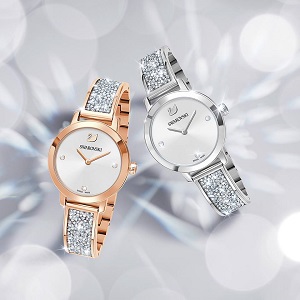20% Blue Light Card discount on full priced items
- Free UK delivery for orders over £25
- Complimentary packaging & gift message
- Express delivery £6.95
Metals Guide
Precious metals, such as sterling silver, gold and platinum have traditionally been used to craft jewellery, with gold and platinum being especially popular metals in which to create wedding jewellery. Modern jewellery production techniques have seen a number of alternative metals become commonly used in many well-known and respected jewellery brands, and these are often used make affordable but high quality ranges of jewellery. Metals such as titanium, stainless steel, rhodium and high quality gold, rose gold or palladium PVD coatings can be both hard wearing and beautiful. PVD coating is often used in modern jewellery brands such as Swarovski. PVD stands for "physical vapor deposition" and is an effective way of blasting metal with another metal to bond them. PVD coatings tend to be more durable in the long run than traditional gold plating or metal plating.
 Silver is one of the most popular precious metals and is ideal for use in making all types of jewellery. Because it is brighter in colour than other white metals and is soft enough to be made into different shapes, silver has been used in jewellery throughout history. Silver is extremely versatile and can be made into many different shapes and styles due to its malleability. Sterling silver is an alloy, made up of copper and 92.5% pure silver, and carries the 925 sterling silver hallmark stamp. Slightly harder than pure silver, sterling silver is the most popular type of silver for the manufacture of jewellery. Silver items weighing less than 7.78 grams are not required to carry a hallmark, but heavier items are. Shop our silver jewellery here.
Silver is one of the most popular precious metals and is ideal for use in making all types of jewellery. Because it is brighter in colour than other white metals and is soft enough to be made into different shapes, silver has been used in jewellery throughout history. Silver is extremely versatile and can be made into many different shapes and styles due to its malleability. Sterling silver is an alloy, made up of copper and 92.5% pure silver, and carries the 925 sterling silver hallmark stamp. Slightly harder than pure silver, sterling silver is the most popular type of silver for the manufacture of jewellery. Silver items weighing less than 7.78 grams are not required to carry a hallmark, but heavier items are. Shop our silver jewellery here.
 Yellow gold is a timeless classic metal, being one of the only pure metals that is naturally shiny yellow rather than grey or white. Gold has been used throughout history from ancient times, for over 6000 years and has not gone out of fashion in all that time! However, pure 24 carat gold is too soft to be used for jewellery, so is combined with other stronger metals to create an alloy, and is more commonly made into jewellery at 18 (75% gold) and 9 carats (37.5% gold). Gold is resistant to rust and tarnishing and while the shine may fade when in contact with detergents or moisturisers, this is easily rectified by polishing with a soft cloth to restore the shine. Gold jewellery should be stored separately from other jewellery to avoid discolouring. Shop yellow gold and plated gold jewellery.
Yellow gold is a timeless classic metal, being one of the only pure metals that is naturally shiny yellow rather than grey or white. Gold has been used throughout history from ancient times, for over 6000 years and has not gone out of fashion in all that time! However, pure 24 carat gold is too soft to be used for jewellery, so is combined with other stronger metals to create an alloy, and is more commonly made into jewellery at 18 (75% gold) and 9 carats (37.5% gold). Gold is resistant to rust and tarnishing and while the shine may fade when in contact with detergents or moisturisers, this is easily rectified by polishing with a soft cloth to restore the shine. Gold jewellery should be stored separately from other jewellery to avoid discolouring. Shop yellow gold and plated gold jewellery.
 White gold has a shiny, silvery tone and is created when yellow gold, is alloyed with one (or more) white metals – such as nickel, magnesium and palladium. White gold became popular in the 1920’s with art deco style jewellery and has retained its popularity ever since. White gold is a lovely and affordable alternative to platinum and is tarnish free, making it an ideal material to create diamond and gemstone jewellery, and engagement, wedding and eternity rings. White gold is often enhanced by rhodium plating, a metal from the platinum group that is naturally silvery and bright. Rhodium plating can wear slightly over time, so if your rhodium plated jewellery needs re-plating, just bring it to our store and we can arrange for re-plating to look shiny and new. Shop our white gold jewellery.
White gold has a shiny, silvery tone and is created when yellow gold, is alloyed with one (or more) white metals – such as nickel, magnesium and palladium. White gold became popular in the 1920’s with art deco style jewellery and has retained its popularity ever since. White gold is a lovely and affordable alternative to platinum and is tarnish free, making it an ideal material to create diamond and gemstone jewellery, and engagement, wedding and eternity rings. White gold is often enhanced by rhodium plating, a metal from the platinum group that is naturally silvery and bright. Rhodium plating can wear slightly over time, so if your rhodium plated jewellery needs re-plating, just bring it to our store and we can arrange for re-plating to look shiny and new. Shop our white gold jewellery.
 Rose gold is a striking mix of gold and copper, alloyed to create a gorgeous pink tint and is a stylish and on-trend alternative to yellow and white gold. Rose gold is popular not just for rings but for all jewellery types, including pendants, bracelets, earrings and watches. The colour of rose gold depends on the ratio of copper to gold, ranging from a soft pink to a deep red. As the copper content increases, the colour of the gold deepens to red. Rose gold can be easily mixed and matched with other jewellery metals and is currently very popular, in particular for stacking bracelets, rings and mix and match jewellery. Shop our rose gold and rose plated jewellery.
Rose gold is a striking mix of gold and copper, alloyed to create a gorgeous pink tint and is a stylish and on-trend alternative to yellow and white gold. Rose gold is popular not just for rings but for all jewellery types, including pendants, bracelets, earrings and watches. The colour of rose gold depends on the ratio of copper to gold, ranging from a soft pink to a deep red. As the copper content increases, the colour of the gold deepens to red. Rose gold can be easily mixed and matched with other jewellery metals and is currently very popular, in particular for stacking bracelets, rings and mix and match jewellery. Shop our rose gold and rose plated jewellery.
 Platinum is a strong, pure and naturally silvery toned metal which is considered a prestigious material for jewellery crafting. Many people choose platinum because of its hardness and resistance to tarnishing, making it a practical, hard wearing and classic metal for everyday jewellery. It is particularly popular with brides and grooms for wedding bands and engagement rings. Its durability and strength make it brilliant for setting diamonds and other precious gemstones. Whilst gold contains a combination of metals, platinum's purity makes it naturally hypoallergenic and ideal for those with skin sensitivities. It can wear a little over time if it comes into contact with stronger materials, such as diamonds or steel, but can be easily re-polished. Shop our platinum jewellery here.
Platinum is a strong, pure and naturally silvery toned metal which is considered a prestigious material for jewellery crafting. Many people choose platinum because of its hardness and resistance to tarnishing, making it a practical, hard wearing and classic metal for everyday jewellery. It is particularly popular with brides and grooms for wedding bands and engagement rings. Its durability and strength make it brilliant for setting diamonds and other precious gemstones. Whilst gold contains a combination of metals, platinum's purity makes it naturally hypoallergenic and ideal for those with skin sensitivities. It can wear a little over time if it comes into contact with stronger materials, such as diamonds or steel, but can be easily re-polished. Shop our platinum jewellery here.
For more information on hallmarks, find a useful metals hallmark guide here.









